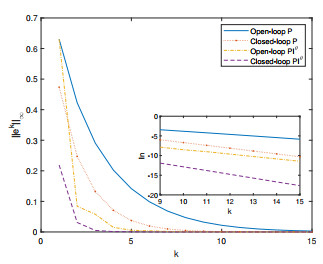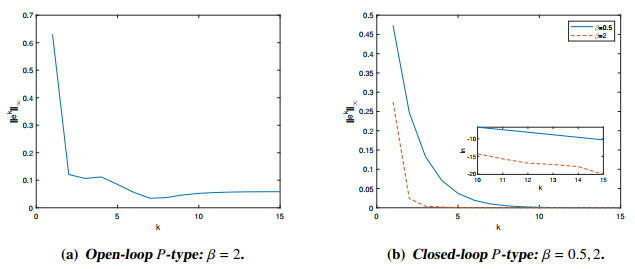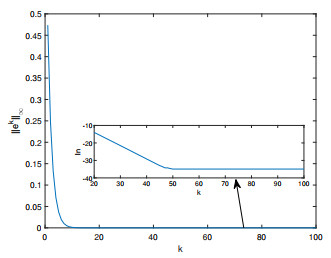1.
Introduction and main results
In this paper, we investigate the common transcendental directions of derivatives, primitives and Jackson difference operators of f, which is a non-trivial solution of the linear differential equation
where n(≥2) is an integer and Ai(z)(i=0,1,...,n−1) are entire functions of finite lower order.
To accurately describe and study our problems, we need some basic results on complex dynamics of transcendental meromorphic functions. Let f: C→C∪{∞} be a transcendental meromorphic function in the complex plane C, and fn(z)=f∘(fn−1)(z),n∈N denote the n-th iterate of f(z). The Fatou set of f is denoted by F(f), that is the set of points such that {fn}∞n=1 is defined and normal in a neighborhood of z and the Julia set J(f) is its complement. It is well-known that F(f) is open, J(f) is closed and non-empty. More basic knowledge of complex dynamics can be found in [3].
For a transcendental entire function f, Baker [2] first observed that J(f) cannot lie in finitely many rays emanating from the origin. In 1994, Qiao [11] introduced the limiting directions of a Julia set from a viewpoint of angular distribution.
Definition 1.1. [11] The ray argz=θ(θ∈[0,2π)) is said to be a limiting direction of J(f) if Ω(θ−ε,θ+ε)∩J(f) is unbounded for any ε>0, where Ω(θ−ε,θ+ε)={z∈Cc|argz∈(θ−ε,θ+ε)}.
The set of arguments of all limit directions of J(f) is denoted by
It is known that Δ(f) is closed and measurable and we use mesΔ(f) stands for its linear measure. For brevity, we call a limiting direction of the Julia set of f a Julia limiting direction of f. The Nevanlinna theory is an important tool in this paper. In what follows, we use some standard notations such as proximity function m(r,f), counting function of poles N(r,f), Nevanlinna characteristic function T(r,f) and some basic results in [7]. The order ρ(f) and lower order μ(f) of f(z) are defined by
respectively. The deficiency of the value a is denoted by δ(a,f), and if δ(a,f)>0, we say that a is a Nevanlinna deficient value of f(z).
Qiao[10] proved that if f(z) is a transcendental entire function of finite lower order, then mesΔ(f)≥min{2π,π/μ(f)}. Recall J(tanz)=R, then we know the conclusion fails for general meromorphic functions. But under some conditions, Qiao's result can be generalized. In [16], Zheng et al. proved that for a transcendental meromorphic function f(z) with μ(f)<∞ and δ(∞,f)>0, if J(f) has an unbounded component, then mesΔ(f)≥min{2π,4μ(f)arcsin√δ(∞,f)2}. In [12], Qiu and Wu showed that the conclusion is still valid without the assumption that J(f) has an unbounded component. Some new progress on Julia limiting directions can be found in [5,8,13,14,15,16]. Especially, in order to analyze the structure of the limit directions, Wang and Yao[15] introduced a new direction in which f grows faster than any polynomials is a limit direction of f.
Definition 1.2. [15] A value θ∈[0,2π) is said to be a transcendental direction of f if there exists an unbounded sequence of {zn} such that
We use TD(f) to denote the union of all transcendental directions of f. Clearly, TD(f) is non-empty and closed.
It is known that the growth properties of the function can affect the geometry and topology of the Julia sets and we can find that even weak growth along some unbounded sequence could be closely related to Julia limiting directions. Indeed, Wang and Yao obtained the following.
Theorem A.[15] Let f be a transcendental meromorphic function. If either f has a direct tract or J(f)∪{∞} is uniformly perfect at some point in J(f). Then
Remark 1.1. Actually, every transcendental entire function has at least a direct, and if J(f) has an unbounded component, then J(f)∪{∞} is uniformly perfect at some point in J(f). Theorem A implies that many Julia limiting directions come from transcendental directions. Therefore, it is interesting to study the properties of transcendental directions since this may help us study the structure of Julia limiting direction. Although the concept of the transcendental direction is not introduced before, the idea to associate the Julia limiting directions with the growth rate of f in the directions has already appeared in Qiao[10] and Zheng-Wang-Huang[16]. Here, we give an example to illustrate the concepts of the transcendental direction and the Julia limiting direction.
Example 1.1. Let f(z)=λexpz(λ∈C∖{0}). Clearly, TD(f)=[−π2,π2]. When 0<λ≤1e, J(f) is contained in the half plane Re(z)≥1, so Δ(f)=TD(f), while Δ(expz)=[0,2π) since J(expz)=C. This also shows that TD(f)⊂Δ(f) may happen.
By the results in [10,12,16], the measure of Δ(f) has a lower bound for some transcendental meromorphic functions, then the relationship TD(f)⊂Δ(f) in Theorem A motivates us to pose a question : Can we estimate the lower bound of measure of TD(f)? In [15], Wang and Yao partially answered this question.
Theorem B.[15] Let f be a transcendental meromorphic function. If μ(f)<∞ and δ(∞,f)>0, then
Remark 1.2. From Theorem B, a natural question arises: For meromorphic functions with infinite lower order, what is sufficient conditions for the existence of lower bound of the measure of TD(f)? Moreover, for entire functions and their derivatives, the difference between their local properties are astonishing. Then there exists another question: What is the relation between the transcendental directions of entire functions and that of their derivatives?
Inspired by Theorem B, we try to answer the two questions. Actually, if f is a transcendental meromorphic function of finite lower order, then it must have sequences of Pólya peaks (see Lemma 2.3). Therefore, we can estimate the lower bound of the measure of set of transcendental directions of transcendental meromorphic functions of finite lower order by using sequences of Pólya peaks. But for a transcendental meromorphic function f with infinite lower order, it is impossible to use sequences of Pólya peaks to consider the lower bound of the measure of TD(f) because Lemma 2.3 can only apply to a transcendental meromorphic function with finite lower order. Therefore, we need to seek a new method to study the transcendental directions of entire solutions with infinite lower order. Indeed, we shall show that the transcendental directions of f(z), its k-th derivatives and its k-th integral primitive have a large amount of common transcendental directions. Set I(f)=⋂k∈ZTD(f(k)), where f(k) denotes the k-th derivative of f(z) for k≥0 or k-th integral primitives of f(z) for k<0. Our result can be stated as follows.
Theorem 1.1. Let Ai(z)(i=0,1,...,n−1) be entire functions of finite lower order such that A0 is transcendental and m(r,Ai)=o(m(r,A0))(i=1,2,...,n−1) as r→∞. Then, every non-trivial solution f of Eq (1.1) satisfies mesI(f)≥min{2π,π/μ(A0)}.
Remark 1.3. It is easy to see that every non-trivial solution f of Eq (1.1) is an entire function with infinite lower order. Since A0(z) is entire and transcendental, then limr→∞m(r,A0)logr=∞. Applying the lemma of logarithmic derivatives to Eq (1.1) yields
outside of a possible exceptional set E of finite linear measure. Therefore, all non-trivial solutions of Eq (1.1) are entire functions with infinite lower order.
Remark 1.4. In [14], Wang and Chen proved mes(⋂k∈ZΔ(f(k)))≥min{2π,π/μ(A0)} under the conditions of Theorem 1.1. Clearly, in the case that μ(A0)<1/2, we know all Julia limiting directions of f come from its transcendental directions.
In [4], Cao et al. recalled the Jackson difference operator
For k∈N∪{0}, the Jackson k-th difference operator is denoted by
Clearly, if f is differentiable,
From Theorem 1.1, we know the set of transcendental directions of derivatives of every non-trivial solution f(z) of Eq (1.1) must have a definite range of measure with some additional conditions. Naturally, a question arise: Can we estimate the lower bound of measure of TD(Dkqf)? Furthermore, what is the relation between the transcendental directions of entire functions and those of their Jackson difference operators?
To answer these questions, we first need to figure out the growth of Dkqf(z). In 2020, Long et al. [9] considered the growth of q difference operator ˆDqf(z):=f(qz)−f(z) of the transcendental meromorphic function and obtained the following result.
Theorem C.[9] If f is a transcendental meromorphic function and |q|≠1, then ρ(ˆDqf)=ρ(f) and μ(ˆDqf)=μ(f).
Moreover, in the introduction of [9], the authors pointed out that this result also holds for Jackson difference operators. In fact, we know the set of transcendental directions of a transcendental entire function with finite lower order must have a definite range of measure from Theorem B. Hence, the left is the case of entire functions with infinite lower order. From Remark 1.3, we know that every non-trivial solution f of Eq (1.1) is an entire function with infinite lower order, and by [9], the k-th Jackson difference operator Dkqf of f is also of infinite lower order if f is a transcendental meromorphic with infinite lower order. Therefore, motivated by these facts, we try to study the common transcendental directions of solutions of Eq (1.1) and their Jackson difference operator. Here, we denote R(f)=⋂k∈N∪{0}TD(Dkqf), where q∈(0,+∞)∖{1}. Then we have the following result.
Theorem 1.2. Let Ai(z)(i=0,1,...,n−1) be entire functions of finite lower order such that A0 is transcendental and m(r,Ai)=o(m(r,A0))(i=1,2,...,n−1) as r→∞. Then, every non-trivial solution f of Eq (1.1) satisfies mesR(f)≥min{2π,π/μ(A0)} for all q∈(0,+∞)∖{1}.
Remark 1.5. Although limq→1Dkqf(z)=f(k)(z), it just means that the k-th derivative is the limit of a family of Jackson difference operator. In Theorem 1.1, our calculation of the integral primitives of f(z) depends on the lemma of logarithmic derivatives in the angular domain. At present, we only have the Jackson difference analogue of logarithmic derivative lemma for meromorphic functions with zero order in the whole plane, see [4]. Therefore, for k<0, we do not have sufficient conditions to estimate the lower bound of measure of TD(Dkqf). Thus, Theorem 1.1 still makes sense.
Usually, we cannot expect too much close relations of transcendental directions between ˆDqf and f. But Theorem C shows us that f and ˆDqf have both the same order and lower order. So we may also consider the measure of transcendental directions of k-th q difference operators of meromorphic functions with infinite lower order. Now, we denote the k-th q difference operator by
where k∈N∪{0}. Here, we denote E(f)=⋂k∈N∪{0}TD(ˆDkqf), where q∈(0,+∞)∖{1}. Then we have the following result.
Theorem 1.3. Let Ai(z)(i=0,1,...,n−1) be entire functions of finite lower order such that A0 is transcendental and m(r,Ai)=o(m(r,A0))(i=1,2,...,n−1) as r→∞. Then, every non-trivial solution f(z) of Eq (1.1) satisfies mesE(f)≥min{2π,π/μ(A0)} for all q∈(0,+∞)∖{1}.
2.
Preliminary lemmas
Before introducing lemmas, we recall the Nevanlinna characteristic in an angle, see[6,17]. Assuming 0<α<β<2π, we denote
and use ¯Ω(α,β) to denote the closure of Ω(α,β).
Let g(z) be meromorphic on the angular ¯Ω(α,β), we define
where ω=π/(β−α), and bn=|bn|eiβn are the poles of g(z) in ¯Ω(α,β) according to their multiplicities. The Nevanlinna angular characteristic is defined as follows:
In particular, we use σα,β(g)=lim supr→∞logSα,β(r,g)logr to denote the order of Sα,β(r,g). The following lemmas play the key roles in proving our results.
Lemma 2.1. [17] Let f(z) be a meromorphic function on Ω(α−ε,β+ε) for ε>0 and 0<α<β<2π. Then
Lemma 2.2. [8] Let z=rexp(iψ),r0+1<r and α≤ψ≤β, where 0<β−α≤2π. Suppose that n(≥2) is an integer, and that g(z) is analytic in Ω(r0,α,β) with σα,β<∞. Choose α<α1<β1<β, then, for every ε∈(0,βj−αj2)(j=1,2,...,n−1) outside a set of linear measure zero with
there exist K>0 and M>0 only depending g, ε1,...,εn−1 and Ω(αn−1,βn−1), and not depending on z such that
and
for all z∈Ω(αn−1,βn−1) outside an R-set D, where k=π/(β−α) and kεj=π/(βj−αj(j=1,2,...,n−1)).
To estimate the measure of TD(f), we need to find the directions in which f grows faster than any polynomial. For this we will use the following result of Baernstein.
Lemma 2.3. [1] Let f(z) be a transcendental meromorphic function of finite lower order μ, and have one deficient value a. Let Λ(r) be a positive function with Λ(r)=o(T(r,f)) as r→∞. Then for any fixed sequence of Pólya peaks {rn} of order μ, we have
where DΛ(r,a) is defined by
and for finite a,
3.
Proofs of theorems
Proof of Theorem 1.1. The assertion mesI(f)≥σ:=min{2π,π/μ(A0)} would be obtained by reduction to absurdity. Suppose on the contrary that mesI(f)<σ:=min{2π,π/μ(A0}. Then t:=σ−mesI(f)>0. For every k∈Z, TD(f(k)) is closed, and so I(f) is a closed set. Denoted by S:=(0,2π)∖I(f) the complement of I(f). Then S is open, so it consists of at most countably many open intervals. We can choose finitely many open intervals Ii=(αi,βi)(i=1,2,...,m) in S such that
For every θi∈Ii, argz=θi is not a transcendental direction of f(k) for some k∈Z. Then there exists an angular domain Ω(θi−ξθi,θi+ξθi) such that
where ξθi is a constant depending on θi. Hence, ⋃θi∈Ii(θi−ξθi,θi+ξθi) is an open covering of [αi+ε,βi−ε] with 0<ε<min{(βi−αi)/6,i=1,2,...,m}. By Heine-Borel theorem, we can choose finitely many θij, such that
From (3.2) and the definition of transcendental direction, we have
where d is a positive constant, α∗ij=θij−ξθij+ε and β∗ij=θij+ξθij−ε.
Case 1. Suppose k≥0. We note the fact that
where c is a constant, and the integral path is the segment of a straight line from 0 to z. From this and (3.3), we can deduce f(k−1)(z)=O(|z|d+1) for z∈Ω(α∗ij,θ∗ij). Repeating the discussion k times, we can obtain
It means that
Case 2. Suppose k<0. Clearly, for f(k)(z), there is not just one primitive, but a whole family. However, for any integral primitive f(k+1)(z), we have
for |k|ε′=ε.
By (3.3) and Lemma 2.1, we can obtain
Using the discussion |k| times, we have
It follows from (3.4) and (3.5) that whatever k is positive or not, we always have
Therefore, by Lemma 2.2, there exists two constants M>0 and K>0 such that
for all z∈⋃mi=1⋃sij=1Ω(θij−ξθij+3ε,θij+ξθij−3ε) outside a R-set H.
Next, we define
It is clear that Λ(r)=o(m(r,A0)) and m(r,Ai)=o(Λ(r)),i=1,2,...,n. Since A0 is entire, ∞ is a deficient value of A0 and δ(∞,A0)=1. By Lemma 2.3, there exists an increasing and unbounded sequence {rk} such that
where
and all rk∉{|z|:z∈H}. Set
one can see that
From (3.10), we know DΛ(rn)⊂En for each n. Then
It follows from (3.8), (3.11) and (3.12) that
Clearly,
Let Jij=(θij−ξθij+3ε,θij+ξθij−3ε). Then
where ζ=∑mi=1si. Choosing ε small enough, we can deduce
Thus there exists an open interval Ji0j0 such that
Let F=Ji0j0∩U, from (3.9), there exists a subsequence {rkj} of {rk} such that
On the other hand, coupling (1.1) and (3.7) leads to
(3.13) and (3.14) give out
which is impossible since m(r,Ai)=o(Λ(r))(i=1,...,n−1) as r→∞. Hence, we get
Proof of Theorem 1.2. Firstly, we suppose that
Then t:=σ−mesR(f)>0. Similarly as in the proof of Theorem 1.1, we have
where d is a positive constant, α∗ij=θij−ξθij+ε and β∗ij=θij+ξθij−ε.
By the definition of Jackson k-th difference operator,
Therefore,
Thus, there exists a positive constants C such that
Case 1. Suppose q∈(0,1). Clearly, there exists a positive integer m such that (1q)m≤|z|≤(1q)m+1 for sufficiently large |z|. Therefore, 1≤|qmz|≤1q. Then there exists a positive constant M1 such that |Dk−1qf(qmz)|≤M1 for all z∈{z|1≤|qmz|≤1q}. Using inequality (3.20) repeatedly, we have
Taking the sum of all inequalities, we get
Therefore,
Repeating the operations from (3.17) to (3.23), we have
Case 2. Suppose q∈(1,+∞). If |z| is sufficiently large, there exists a positive integer n such that qn≤|z|≤qn+1. And this is exactly 1≤|zqn|≤q. Thus, there exists a positive constant M2 such that |Dk−1qf(zqn)|≤M2 for all z∈{z|1≤|zqn|≤q}. Using inequality (3.20) repeatedly, we have
Taking the sum of all inequalities, we get
Therefore,
Similarly as in (3.17)–(3.20), we have
It means that
By the same reasoning as in (3.6) to (3.15), we can get a contradiction. Hence, we get
This completes the proof of Theorem 1.2.
Proof of Theorem 1.3. Using ˆDkqf(z) instead of Dkqf(z) in the proof of Theorem 1.2 and by the definition of k-th q difference operator, we can prove Theorem 1.3 similarly.
4.
Conclusions
In this article, we obtained the lower bound of the measure of the set of transcendental directions of a class of transcendental entire functions with infinite lower order, which are solutions of linear differential equations. We also discussed the case for the Jackson difference operators and q difference operators of such functions. Actually, we know the set of transcendental directions of a transcendental entire function with finite lower order must have a definite range of measure from Theorem B. Hence, the left is the case of entire functions with infinite lower order. Usually, it is difficult to estimate the lower bound of measure of the set of transcendental directions of a transcendental entire function with infinite lower order. However, our article obtained some results on the transcendental directions for a class of entire functions with infinite lower order. But for more general cases, we still need to find other ways to investigate the lower bound of the measure of the set of transcendental directions.
Acknowledgments
The work was supported by NNSF of China (No.11971344), Research and Practice Innovation Program for Postgraduates in Jiangsu Province (KYCX20\_2747).
Conflict of interest
The authors declare that they have no conflict of interest.
















 DownLoad:
DownLoad: